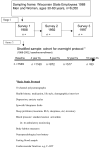Rationale, design and findings from the Wisconsin Sleep Cohort Study: Toward understanding the total societal burden of sleep disordered breathing
- PMID: 20161300
- PMCID: PMC2699290
- DOI: 10.1016/j.jsmc.2008.11.003
Rationale, design and findings from the Wisconsin Sleep Cohort Study: Toward understanding the total societal burden of sleep disordered breathing
Figures

The number of cases of SDB (prevalence), multiplied by
The costs of SDB, including:
direct costs
monentary cost of diagnosis and treatment,
distress, discomfort associated with having SDB to the individual sufferer, including unsatisfactory sleep, low motivation, problems with daytime functioning, quality of life, relationships, etc,
loss to family and society (loss of potential contributions to community e.g., jobs, volunteer sevices)
morbidity attributable to SDB (e.g., hypertension, depression)
loss of years of life attributable to SDB
indirect costs
SDB exacerbation of comorbidity
worse prognosis for other disorders due to SDB-related behavioral morbidity (e.g., low compliance with therapy for other disorders, lack of exercise)
Modifying factors
prevention programs to reduce prevalence and progression of SDB (e.g., weight loss)
increases in factors that cause or worse SDB (e.g., ongoing obesity epidemic, aging of the popuation)
treatment of SDB that prevents or reduces adverse outcomes



Similar articles
-
Coronary heart disease incidence in sleep disordered breathing: the Wisconsin Sleep Cohort Study.Sleep. 2015 May 1;38(5):677-84. doi: 10.5665/sleep.4654. Sleep. 2015. PMID: 25515104 Free PMC article.
-
Sleep-disordered breathing and self-reported general health status in the Wisconsin Sleep Cohort Study.Sleep. 1998 Nov 1;21(7):701-6. Sleep. 1998. PMID: 11286346
-
Smoking as a risk factor for sleep-disordered breathing.Arch Intern Med. 1994 Oct 10;154(19):2219-24. Arch Intern Med. 1994. PMID: 7944843
-
A potential widespread and important role for sleep-disordered breathing in pressure injury development and delayed healing among those with spinal cord injury.Spinal Cord. 2020 May;58(5):626-629. doi: 10.1038/s41393-020-0434-6. Epub 2020 Feb 11. Spinal Cord. 2020. PMID: 32047253 Review.
-
Obstructive sleep-disordered breathing, enuresis and combined disorders in children: chance or related association?Swiss Med Wkly. 2017 Feb 3;147:w14400. doi: 10.4414/smw.2017.14400. eCollection 2017. Swiss Med Wkly. 2017. PMID: 28165541 Review.
Cited by
-
Vitamin D deficiency in patients evaluated for obstructive sleep apnea: is it associated with disease severity?Sleep Breath. 2021 Jun;25(2):1109-1117. doi: 10.1007/s11325-020-02142-w. Epub 2020 Jul 10. Sleep Breath. 2021. PMID: 32648186
-
Correlation of the Epworth Sleepiness Scale and Sleep-Disordered Breathing in Men and Women.J Clin Sleep Med. 2019 Jan 15;15(1):33-38. doi: 10.5664/jcsm.7564. J Clin Sleep Med. 2019. PMID: 30621827 Free PMC article.
-
A comparison of CPAP and CPAPFLEX in the treatment of obstructive sleep apnea in World Trade Center responders: study protocol for a randomized controlled trial.Trials. 2015 Sep 10;16:403. doi: 10.1186/s13063-015-0907-7. Trials. 2015. PMID: 26357928 Free PMC article. Clinical Trial.
-
Bidirectional relationships of comorbidity with obstructive sleep apnoea.Eur Respir Rev. 2022 May 4;31(164):210256. doi: 10.1183/16000617.0256-2021. Print 2022 Jun 30. Eur Respir Rev. 2022. PMID: 35508332 Free PMC article. Review.
-
Obstructive sleep apnea: transition from pathophysiology to an integrative disease model.J Sleep Res. 2022 Aug;31(4):e13616. doi: 10.1111/jsr.13616. Epub 2022 May 24. J Sleep Res. 2022. PMID: 35609941 Free PMC article. Review.
References
-
- Colten H, Altevogt B, editors. Committee on Sleep Medicine and Research, Board on Health Sciences Policy:Sleep disorders and sleep deprivation: an unmet public health problem. Washington DC: Institute of Medicine/National Academies Press; 2006. pp. 20–32. - PubMed
-
- Somers VK, White DP, Amin R, et al. Sleep Apnea and Cardiovascular Disease. An American Heart Association/American College of Cardiology Foundation Scientific Statement. Circulation. 2008 Jul 28 - PubMed
-
- Namen AM, Dunagan DP, Fleischer A, Tillett J, Barnett M, McCall WV, Haponik EF. Increased physician-reported sleep apnea: the National Ambulatory Medical CareSurvey. Chest. 2002;121(6):1741–7. - PubMed
-
- Ball EM, Simon RD, Jr, Tall AA, Banks MB, Nino-Murcia G, Dement WC. Diagnosis and treatment of sleep apnea within the community. The Walla Walla Project. Arch Intern Med. 1997;157(4):419–24. - PubMed
Grants and funding
LinkOut - more resources
Full Text Sources

